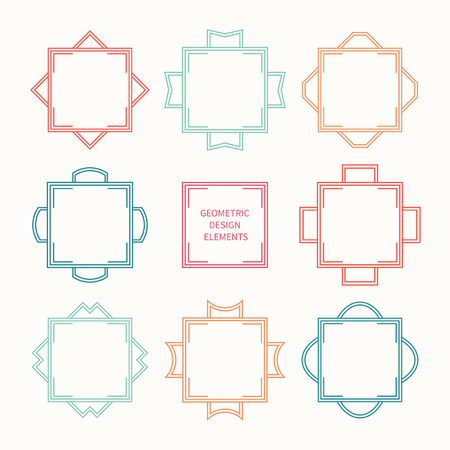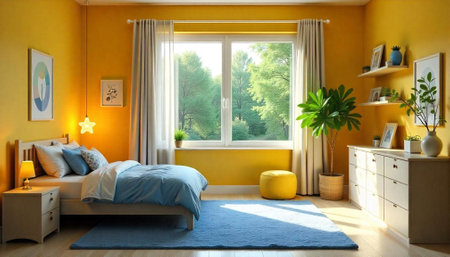Understanding Vastu and its Significance in Indian Homes
Vastu Shastra, an ancient Indian science of architecture, has been guiding the design and arrangement of homes for centuries. Deeply embedded in Indian culture, Vastu offers a holistic approach to harmonising energy flow within living spaces. For Indian families, the bedroom is not just a place to sleep but a sanctuary for rest and rejuvenation. The foundational principles of Vastu focus on aligning the home with natural elements and cardinal directions, thereby enhancing well-being and prosperity. In particular, Vastu emphasises the significance of specific colours, layouts, and placements within the bedroom to foster better sleep quality and positive energy. By understanding these core concepts, one can make thoughtful choices that reflect both tradition and personal comfort while ensuring peaceful sleep in accordance with age-old wisdom.
2. The Science Behind Colour and Sleep Quality
Colours play a significant role in influencing our psychological state, mood, and even sleep quality. In India, the ancient science of Vastu Shastra has long emphasized the importance of selecting suitable colours for different rooms to promote harmony and well-being. Modern psychological and scientific research also supports these traditional beliefs, showing that the shades surrounding us can affect our emotions, relaxation levels, and biological rhythms.
How Colours Affect Mood and Sleep
Scientific studies suggest that certain colours have calming effects, while others may energize or even agitate. For instance, cooler hues like blue and green are known to lower heart rate and blood pressure, creating an environment conducive to relaxation and sleep. On the other hand, warm or vibrant colours like red or orange can stimulate alertness and excitement, which may hinder restful sleep.
Scientific Insights: Indian Context
Research conducted in India has shown that individuals exposed to softer shades in their bedrooms report better sleep quality. This aligns closely with Vastu recommendations, which advocate for peaceful tones that resonate with positive energy flows. Such findings highlight how colour psychology is intertwined with cultural wisdom in Indian homes.
Comparison Table: Colour Effects on Sleep (Vastu & Science)
| Colour | Vastu Recommendation | Psychological/Scientific Effect | Suitability for Bedrooms |
|---|---|---|---|
| Blue | Highly recommended for calmness | Promotes relaxation, lowers stress | Excellent |
| Green | Encouraged for healing vibes | Reduces anxiety, induces tranquility | Very Good |
| Pale Yellow | Brings warmth and positivity | Lifts mood gently without overstimulation | Good |
| White/Cream | Symbolizes purity and peace | Cleanses mind, neutral effect on sleep | Good |
| Red/Orange | Avoid in bedrooms due to excess energy | Stimulates brain activity; may disrupt sleep patterns | Poor |
| Purple/Dark Shades | Avoid as it may attract negativity or sadness | Might cause restlessness or depressive moods if too intense | Poor to Moderate (depends on shade) |
The above table demonstrates how both Vastu guidelines and modern research converge on similar conclusions regarding bedroom colours. By understanding these influences, Indian homeowners can make informed choices for a more restful night’s sleep.

3. Auspicious Bedroom Colours According to Vastu
Vastu Shastra, the ancient Indian science of architecture and design, places great importance on the selection of colours for bedroom spaces to promote restful sleep and positive vibrations. According to Vastu principles, certain colours are considered highly auspicious for bedroom walls, décor, and even bedding. These shades not only soothe the mind but also harmonise energies in the room.
Recommended Colours for Bedroom Walls
Soft tones like light blue, gentle green, or subtle lavender are favoured by Vastu experts as they evoke calmness and tranquillity. Blue represents serenity and promotes deep rest, making it ideal for those seeking relief from stress. Green signifies growth and healing, while lavender is believed to ease anxiety and encourage peaceful dreams. Avoid dark or overly vibrant shades such as red or black, as these can create restlessness and disturb sleep patterns.
Choosing Colours for Decor and Accents
For décor elements such as curtains, rugs, and artwork, opt for earthy hues like beige, cream, or pastel yellow. These tones are linked with warmth and stability—qualities that help foster a secure and relaxing atmosphere. Incorporating natural materials in these shades further enhances the room’s grounding energy according to Vastu teachings.
Bedding Colours that Promote Good Sleep
Bedding choices matter just as much as wall colours. Soft white cotton sheets symbolise purity and are widely recommended across Indian households for their cooling effect in hot climates. Light pinks or pastel greens in pillowcases and duvets add a gentle touch of positivity without overwhelming the senses. By aligning your bedroom’s palette with Vastu-approved colours, you invite both better sleep quality and increased harmony into your living space.
4. Colours to Avoid in the Bedroom as per Vastu
While choosing the best colours for sleep quality is essential, it is equally important to be aware of shades that are considered inauspicious or disruptive as per Vastu Shastra. Several hues are believed to create imbalances, disrupt mental peace, and invite negative energies into your sleeping space. Here we analyse these colours with cultural context and their potential adverse impacts on well-being.
Commonly Inauspicious Bedroom Colours
| Colour | Cultural Reasoning (Vastu Perspective) | Potential Negative Effects |
|---|---|---|
| Red | Associated with aggression, overstimulation, and conflict; believed to disturb tranquillity needed for rest | Increased irritability, restlessness, and poor sleep |
| Black/Dark Grey | Symbolises negativity and gloom; absorbs energy rather than reflecting positivity | Feelings of sadness, heaviness, and lethargy |
| Dark Brown | Represents stagnation and lack of growth according to Vastu texts | Dullness, lack of motivation, and possible health issues |
| Bright Yellow/Orange | Too vibrant for restful spaces; may cause hyperactivity if overused | Anxiety, hyperactivity, difficulty falling asleep |
Why Are These Colours Discouraged?
Indian culture places a strong emphasis on harmony between living spaces and personal well-being. According to Vastu experts, the bedroom should be a sanctuary that promotes calmness and rejuvenation. The above-mentioned colours are thought to disrupt this balance by attracting excessive heat (red), darkness (black), or overstimulation (bright yellow/orange). This belief is rooted not only in traditional wisdom but also in psychological studies linking certain colours with emotional responses.
Cultural Insights on Colour Psychology in India
The Indian tradition values subtlety and serenity for bedroom decor. For instance, the avoidance of black is deeply ingrained, as it’s often linked with mourning and ill fortune in Indian households. Similarly, fiery reds are reserved for celebratory occasions like weddings—not for restful environments. By understanding these cultural nuances, you can create a bedroom that aligns with both scientific logic and Indian spiritual principles.
5. Tips for Incorporating Vastu-Friendly Colours in Modern Indian Homes
Blending the ancient wisdom of Vastu Shastra with contemporary Indian interior design is both practical and rewarding. Here are some actionable tips to help you select paints, furnishings, and accessories that enhance sleep quality while honouring Vastu principles and modern aesthetics.
Choose Vastu-Recommended Paint Colours Thoughtfully
Begin by selecting wall paints in gentle shades recommended by Vastu, such as light blue, pastel green, or soft cream. These colours promote tranquillity and restful sleep. To keep your space modern, opt for matte or velvet finishes rather than glossy ones, which can feel overwhelming in a bedroom.
Balance with Modern Furnishings
If repainting is not an option, use Vastu-approved colours through furnishings like bedsheets, curtains, and cushions. For instance, pair crisp white bedsheets with teal or sage green throw pillows. Wooden furniture with natural finishes complements both Vastu guidelines and urban Indian tastes.
Accessorise with Purpose
Accessories offer flexibility in updating your bedroom’s look without major renovations. Use lampshades, rugs, and artwork in calming hues—think sky blue or muted yellows. Brass accents or handwoven textiles add a touch of Indian tradition while keeping the decor fresh.
Respect Zonal Colour Placement
According to Vastu, each direction benefits from specific colours: use pale yellow in the southwest for stability or pale green in the northeast for positivity. Place coloured elements strategically—perhaps a green potted plant near your window or a yellow lampshade on your nightstand—to subtly align with these recommendations.
Mix Tradition with Contemporary Trends
Indian homes often showcase vibrant patterns and textures. Choose modern geometric prints or minimalistic designs in Vastu-friendly colours for bed linens and wall art. This maintains cultural authenticity while fitting into current interior trends.
Final Touches: Personal Comfort Matters
No matter how closely you follow Vastu, always prioritise personal comfort. Select materials that are soothing to touch and easy to maintain. The ultimate goal is a harmonious space where traditional beliefs and modern lifestyles coexist—helping you achieve better sleep quality every night.
6. Frequently Asked Questions: Vastu Colours for Sleep
Does every bedroom in the house need to follow Vastu colour recommendations?
While it is ideal to apply Vastu principles throughout the home, many Indian families prioritise the master bedroom or rooms where elders and children sleep, as quality rest is vital for their health. Other bedrooms can benefit from neutral and calming shades, but strict adherence to Vastu may be tailored based on individual needs and family traditions.
Is white always a safe choice according to Vastu?
White symbolises peace and purity in Indian culture and is generally considered a safe, neutral option for bedrooms. However, combining white with pastel shades like light blue, green, or soft pink—aligned with Vastu guidelines—can further enhance restful energy and positivity.
Can dark colours be used at all in the bedroom?
Many Indian families believe that dark colours such as red, black, or deep brown create heaviness and disturb peaceful sleep. According to Vastu Shastra, these shades should be avoided or used minimally as accents rather than dominant wall colours. Lighter tones are preferred for promoting calmness and mental clarity.
What if my favourite colour does not align with Vastu?
Personal preferences matter, and emotional comfort is important for good sleep. If your preferred shade is not Vastu-recommended, you can incorporate it through bed linen, cushions, or artwork rather than painting entire walls. This approach balances individual taste with traditional wisdom for better sleep quality.
How soon will I notice changes in my sleep after changing bedroom colours?
The impact of Vastu colours on sleep quality varies by individual. Some people feel an immediate sense of tranquillity, while others notice gradual improvement over days or weeks. Consistency in maintaining a clutter-free, peaceful environment alongside the right colours enhances positive results for most Indian families.
Are there any scientific studies supporting Vastu colour principles?
While Vastu Shastra is rooted in ancient Indian tradition rather than modern science, several global studies agree that room colours influence mood and sleep quality. Soft blues, greens, and earthy tones have been shown to lower stress and promote relaxation—validating Vastus emphasis on calming shades for the bedroom.

